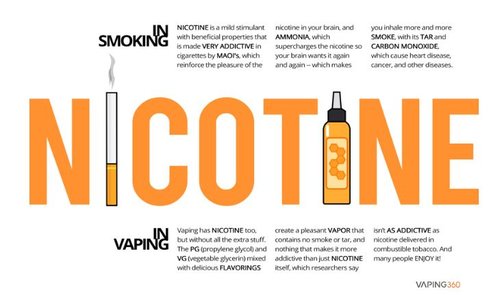My comments:
This is a very interesting article which explains what else is added to cigarettes to aid nic absorption and increase addiction, which consequently explains why smokers find it so difficult to stop smoking, even when they switch to vaping.
Furthermore, it explains why the smoke from cigarettes is so harmful. An acquaintance of mine had a stroke a few years ago and her doctor subsequently told her to stop smoking, not because of the nicotine, but because of the smoke. However, he didn't explain why! (And obviously he didn't know about vaping either, otherwise he surely would have suggested it).
Article:
"When vapers ask how much nicotine is in a cigarette, it’s often because they’re trying to calculate what nicotine concentration they want in e-liquid. The idea is to mimic the hit they get from cigarettes, and get the same nicotine experience from vaping that they do from smoking.
But knowing how many milligrams of nicotine are in one cigarette won’t necessarily translate to vaping. That’s because the method of delivery is much different, and even an equivalent amount of nicotine won’t provide the same kick when delivered in a vape versus in a cigarette.
How much nicotine is in a cigarette?
There is between 0.65 and 1 gram of tobacco in an average unlit cigarette, which includes somewhere between 7.5 and 13.4 milligrams of nicotine, according to testing done at the Behavioral Endocrinology Laboratory at Penn State University. Newport cigarettes had the most nicotine of any American brand tested, at 13.4 mg per cigarette.
A Marlboro red contains 10.9 mg of nicotine, and the median of all the brands tested was 10.2 mg per cigarette. A separate study by Centers for Disease Control and Prevention (CDC) scientists shows that Newport and Marlboro brands contain about the same amount of nicotine (19.4 and 20.3 mg) per gram of tobacco. The mean nicotine content for all brands tested by the CDC was 19.2 mg per gram of tobacco.
That certainly debunks the claim that one JUUL pod contains “as much nicotine as a pack of cigarettes.” A JUUL pod contains 41 mg of nicotine (0.7 mL X 59 mg/mL), but an average pack of cigarettes contains 204 mg of nicotine (20 cigarettes X 10.2 mg) — and some brands contain considerably more.
But the question shouldn’t be how many milligrams of nicotine are in a cigarette. Rather, the issue is how much nicotine from a cigarette is absorbed by the smoker.
According to Prof. Bernd Mayer of the Department of Pharmacology and Toxicology at Karl-Franzens University Graz (Austria), “Smoking a cigarette results in uptake of approximately 2 mg of nicotine and gives rise to mean arterial plasma concentrations of about 0.03 mg/L (30 ng/ml).” Mayer is a known expert on nicotine, but other researchers have slightly different answers. UCLA professor Arthur Brody says typical “light” cigarettes yield 0.6-1.0 mg, and regular smokes 1.2-1.4 mg per cigarette.
So cigarettes deliver a lot less nicotine to the smoker than they actually contain. The difference may seem huge, but in reality it may not matter. That’s because smokers (and vapers) in large part control their uptake of nicotine, and because other factors account for a big part of a cigarette’s powerful nicotine delivery.
Nicotine is nicotine, right?
When we use nicotine, we ourselves decide how much nicotine we take in — by smoking more or less, faster or slower, more or less often. That’s called self-titration, and all nicotine consumers do it.
You know what it feels like to have too much nicotine, right? [or, as we forumites refer to it, doing a Silver! @Silver] Whether you’re getting the drug from cigarettes or a vape, the effects are the same:
Dizziness
Headache
Nausea
Cold sweats
Insomnia
Racing heart
Anxious or jittery
Ringing ears
But because our bodies know when we’ve had enough, we stop or slow down. For experienced nicotine users, the process is almost subconscious. Self-titration is our brain telling us when our body needs more or less. And those warning signs are what prevent nicotine overdoses. Nobody OD’s on cigarettes or vapes. You’d have to keep inhaling while vomiting and dealing with a splitting headache!
So nic users keep themselves in check with self-titration. But getting nicotine from a cigarette is a little more complicated. Between tobacco itself and the tobacco companies, cigarettes are built to deliver a supercharged dose of nicotine to the brain.
Aside from nicotine, cigarettes contain other chemicals that hyperpower the nicotine delivery of the smoke. Monoamine oxidase inhibitors (MAOI’s) combine with nicotine to produce a reinforcing effect in the brain that makes users want more nicotine more often.
And tobacco companies discovered long ago that adding ammonia to cigarette tobacco created a form of nicotine that was more desirable, and more addictive to the user. By changing the chemistry of the nicotine the smoker absorbs, ammonia supercharges the nicotine as it hits the brain. [my emphasis]
Those are all reasons why we can’t simply compare the nicotine content of a cigarette to an equivalent amount of nic in e-liquid or a nicotine patch. Vapes don’t have ammonia or MAOI’s. That’s why scientists say nicotine in e-cigarettes and nicotine replacement therapy (NRT) products isn’t as addictive as cigarettes.

https://vaping360.com/health/nicotine-in-a-cigarette
This is a very interesting article which explains what else is added to cigarettes to aid nic absorption and increase addiction, which consequently explains why smokers find it so difficult to stop smoking, even when they switch to vaping.
Furthermore, it explains why the smoke from cigarettes is so harmful. An acquaintance of mine had a stroke a few years ago and her doctor subsequently told her to stop smoking, not because of the nicotine, but because of the smoke. However, he didn't explain why! (And obviously he didn't know about vaping either, otherwise he surely would have suggested it).
Article:
"When vapers ask how much nicotine is in a cigarette, it’s often because they’re trying to calculate what nicotine concentration they want in e-liquid. The idea is to mimic the hit they get from cigarettes, and get the same nicotine experience from vaping that they do from smoking.
But knowing how many milligrams of nicotine are in one cigarette won’t necessarily translate to vaping. That’s because the method of delivery is much different, and even an equivalent amount of nicotine won’t provide the same kick when delivered in a vape versus in a cigarette.
How much nicotine is in a cigarette?
There is between 0.65 and 1 gram of tobacco in an average unlit cigarette, which includes somewhere between 7.5 and 13.4 milligrams of nicotine, according to testing done at the Behavioral Endocrinology Laboratory at Penn State University. Newport cigarettes had the most nicotine of any American brand tested, at 13.4 mg per cigarette.
A Marlboro red contains 10.9 mg of nicotine, and the median of all the brands tested was 10.2 mg per cigarette. A separate study by Centers for Disease Control and Prevention (CDC) scientists shows that Newport and Marlboro brands contain about the same amount of nicotine (19.4 and 20.3 mg) per gram of tobacco. The mean nicotine content for all brands tested by the CDC was 19.2 mg per gram of tobacco.
That certainly debunks the claim that one JUUL pod contains “as much nicotine as a pack of cigarettes.” A JUUL pod contains 41 mg of nicotine (0.7 mL X 59 mg/mL), but an average pack of cigarettes contains 204 mg of nicotine (20 cigarettes X 10.2 mg) — and some brands contain considerably more.
But the question shouldn’t be how many milligrams of nicotine are in a cigarette. Rather, the issue is how much nicotine from a cigarette is absorbed by the smoker.
According to Prof. Bernd Mayer of the Department of Pharmacology and Toxicology at Karl-Franzens University Graz (Austria), “Smoking a cigarette results in uptake of approximately 2 mg of nicotine and gives rise to mean arterial plasma concentrations of about 0.03 mg/L (30 ng/ml).” Mayer is a known expert on nicotine, but other researchers have slightly different answers. UCLA professor Arthur Brody says typical “light” cigarettes yield 0.6-1.0 mg, and regular smokes 1.2-1.4 mg per cigarette.
So cigarettes deliver a lot less nicotine to the smoker than they actually contain. The difference may seem huge, but in reality it may not matter. That’s because smokers (and vapers) in large part control their uptake of nicotine, and because other factors account for a big part of a cigarette’s powerful nicotine delivery.
Nicotine is nicotine, right?
When we use nicotine, we ourselves decide how much nicotine we take in — by smoking more or less, faster or slower, more or less often. That’s called self-titration, and all nicotine consumers do it.
You know what it feels like to have too much nicotine, right? [or, as we forumites refer to it, doing a Silver! @Silver] Whether you’re getting the drug from cigarettes or a vape, the effects are the same:
Dizziness
Headache
Nausea
Cold sweats
Insomnia
Racing heart
Anxious or jittery
Ringing ears
But because our bodies know when we’ve had enough, we stop or slow down. For experienced nicotine users, the process is almost subconscious. Self-titration is our brain telling us when our body needs more or less. And those warning signs are what prevent nicotine overdoses. Nobody OD’s on cigarettes or vapes. You’d have to keep inhaling while vomiting and dealing with a splitting headache!
So nic users keep themselves in check with self-titration. But getting nicotine from a cigarette is a little more complicated. Between tobacco itself and the tobacco companies, cigarettes are built to deliver a supercharged dose of nicotine to the brain.
Aside from nicotine, cigarettes contain other chemicals that hyperpower the nicotine delivery of the smoke. Monoamine oxidase inhibitors (MAOI’s) combine with nicotine to produce a reinforcing effect in the brain that makes users want more nicotine more often.
And tobacco companies discovered long ago that adding ammonia to cigarette tobacco created a form of nicotine that was more desirable, and more addictive to the user. By changing the chemistry of the nicotine the smoker absorbs, ammonia supercharges the nicotine as it hits the brain. [my emphasis]
Those are all reasons why we can’t simply compare the nicotine content of a cigarette to an equivalent amount of nic in e-liquid or a nicotine patch. Vapes don’t have ammonia or MAOI’s. That’s why scientists say nicotine in e-cigarettes and nicotine replacement therapy (NRT) products isn’t as addictive as cigarettes.

https://vaping360.com/health/nicotine-in-a-cigarette




